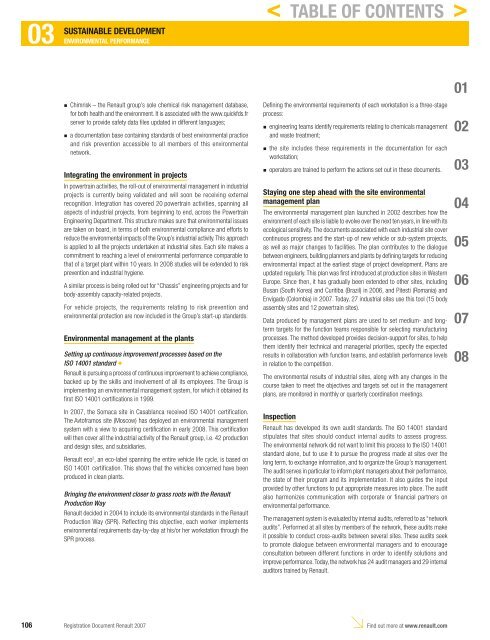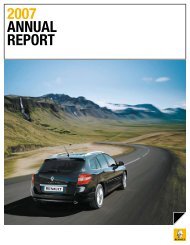2007 Interactive Registration Document - Renault
2007 Interactive Registration Document - Renault
2007 Interactive Registration Document - Renault
You also want an ePaper? Increase the reach of your titles
YUMPU automatically turns print PDFs into web optimized ePapers that Google loves.
03 ENVIRONMENTAL<br />
SUSTAINABLE DEVELOPMENT<br />
PERFORMANCE<br />
n<br />
n<br />
Chimrisk – the <strong>Renault</strong> group’s sole chemical risk management database,<br />
for both health and the environment. It is associated with the www.quickfds.fr<br />
server to provide safety data fi les updated in different languages;<br />
a documentation base containing standards of best environmental practice<br />
and risk prevention accessible to all members of this environmental<br />
network.<br />
Integrating the environment in projects<br />
In powertrain activities, the roll-out of environmental management in industrial<br />
projects is currently being validated and will soon be receiving external<br />
recognition. Integration has covered 20 powertrain activities, spanning all<br />
aspects of industrial projects, from beginning to end, across the Powertrain<br />
Engineering Department. This structure makes sure that environmental issues<br />
are taken on board, in terms of both environmental compliance and efforts to<br />
reduce the environmental impacts of the Group’s industrial activity. This approach<br />
is applied to all the projects undertaken at industrial sites. Each site makes a<br />
commitment to reaching a level of environmental performance comparable to<br />
that of a target plant within 10 years. In 2008 studies will be extended to risk<br />
prevention and industrial hygiene.<br />
A similar process is being rolled out for “Chassis” engineering projects and for<br />
body-assembly capacity-related projects.<br />
For vehicle projects, the requirements relating to risk prevention and<br />
environmental protection are now included in the Group’s start-up standards.<br />
Environmental management at the plants<br />
Setting up continuous improvement processes based on the<br />
ISO 14001 standard ✦<br />
<strong>Renault</strong> is pursuing a process of continuous improvement to achieve compliance,<br />
backed up by the skills and involvement of all its employees. The Group is<br />
implementing an environmental management system, for which it obtained its<br />
fi rst ISO 14001 certifi cations in 1999.<br />
In <strong>2007</strong>, the Somaca site in Casablanca received ISO 14001 certifi cation.<br />
The Avtoframos site (Moscow) has deployed an environmental management<br />
system with a view to acquiring certifi cation in early 2008. This certifi cation<br />
will then cover all the industrial activity of the <strong>Renault</strong> group, i.e. 42 production<br />
and design sites, and subsidiaries.<br />
<strong>Renault</strong> eco 2 , an eco-label spanning the entire vehicle life cycle, is based on<br />
ISO 14001 certifi cation. This shows that the vehicles concerned have been<br />
produced in clean plants.<br />
Bringing the environment closer to grass roots with the <strong>Renault</strong><br />
Production Way<br />
<strong>Renault</strong> decided in 2004 to include its environmental standards in the <strong>Renault</strong><br />
Production Way (SPR). Refl ecting this objective, each worker implements<br />
environmental requirements day-by-day at his/or her workstation through the<br />
SPR process.<br />
Defi ning the environmental requirements of each workstation is a three-stage<br />
process:<br />
engineering teams identify requirements relating to chemicals management<br />
and waste treatment;<br />
the site includes these requirements in the documentation for each<br />
workstation;<br />
operators are trained to perform the actions set out in these documents.<br />
Staying one step ahead with the site environmental<br />
management plan<br />
The environmental management plan launched in 2002 describes how the<br />
environment of each site is liable to evolve over the next ten years, in line with its<br />
ecological sensitivity. The documents associated with each industrial site cover<br />
continuous progress and the start-up of new vehicle or sub-system projects,<br />
as well as major changes to facilities. The plan contributes to the dialogue<br />
between engineers, building planners and plants by defi ning targets for reducing<br />
environmental impact at the earliest stage of project development. Plans are<br />
updated regularly. This plan was fi rst introduced at production sites in Western<br />
Europe. Since then, it has gradually been extended to other sites, including<br />
Busan (South Korea) and Curitiba (Brazil) in 2006, and Pitesti (Romania) and<br />
Envigado (Colombia) in <strong>2007</strong>. Today, 27 industrial sites use this tool (15 body<br />
assembly sites and 12 powertrain sites).<br />
Data produced by management plans are used to set medium- and longterm<br />
targets for the function teams responsible for selecting manufacturing<br />
processes. The method developed provides decision-support for sites, to help<br />
them identify their technical and managerial priorities, specify the expected<br />
results in collaboration with function teams, and establish performance levels<br />
in relation to the competition.<br />
The environmental results of industrial sites, along with any changes in the<br />
course taken to meet the objectives and targets set out in the management<br />
plans, are monitored in monthly or quarterly coordination meetings.<br />
Inspection<br />
<strong>Renault</strong> has developed its own audit standards. The ISO 14001 standard<br />
stipulates that sites should conduct internal audits to assess progress.<br />
The environmental network did not want to limit this process to the ISO 14001<br />
standard alone, but to use it to pursue the progress made at sites over the<br />
long term, to exchange information, and to organize the Group’s management.<br />
The audit serves in particular to inform plant managers about their performance,<br />
the state of their program and its implementation. It also guides the input<br />
provided by other functions to put appropriate measures into place. The audit<br />
also harmonizes communication with corporate or financial partners on<br />
environmental performance.<br />
The management system is evaluated by internal audits, referred to as “network<br />
audits”. Performed at all sites by members of the network, these audits make<br />
it possible to conduct cross-audits between several sites. These audits seek<br />
to promote dialogue between environmental managers and to encourage<br />
consultation between different functions in order to identify solutions and<br />
improve performance. Today, the network has 24 audit managers and 29 internal<br />
auditors trained by <strong>Renault</strong>.<br />
106 <strong>Registration</strong> <strong>Document</strong> <strong>Renault</strong> <strong>2007</strong><br />
Find out more at www.renault.com<br />
n<br />
n<br />
n<br />
< TABLE OF CONTENTS ><br />
01<br />
02<br />
03<br />
04<br />
05<br />
06<br />
07<br />
08




